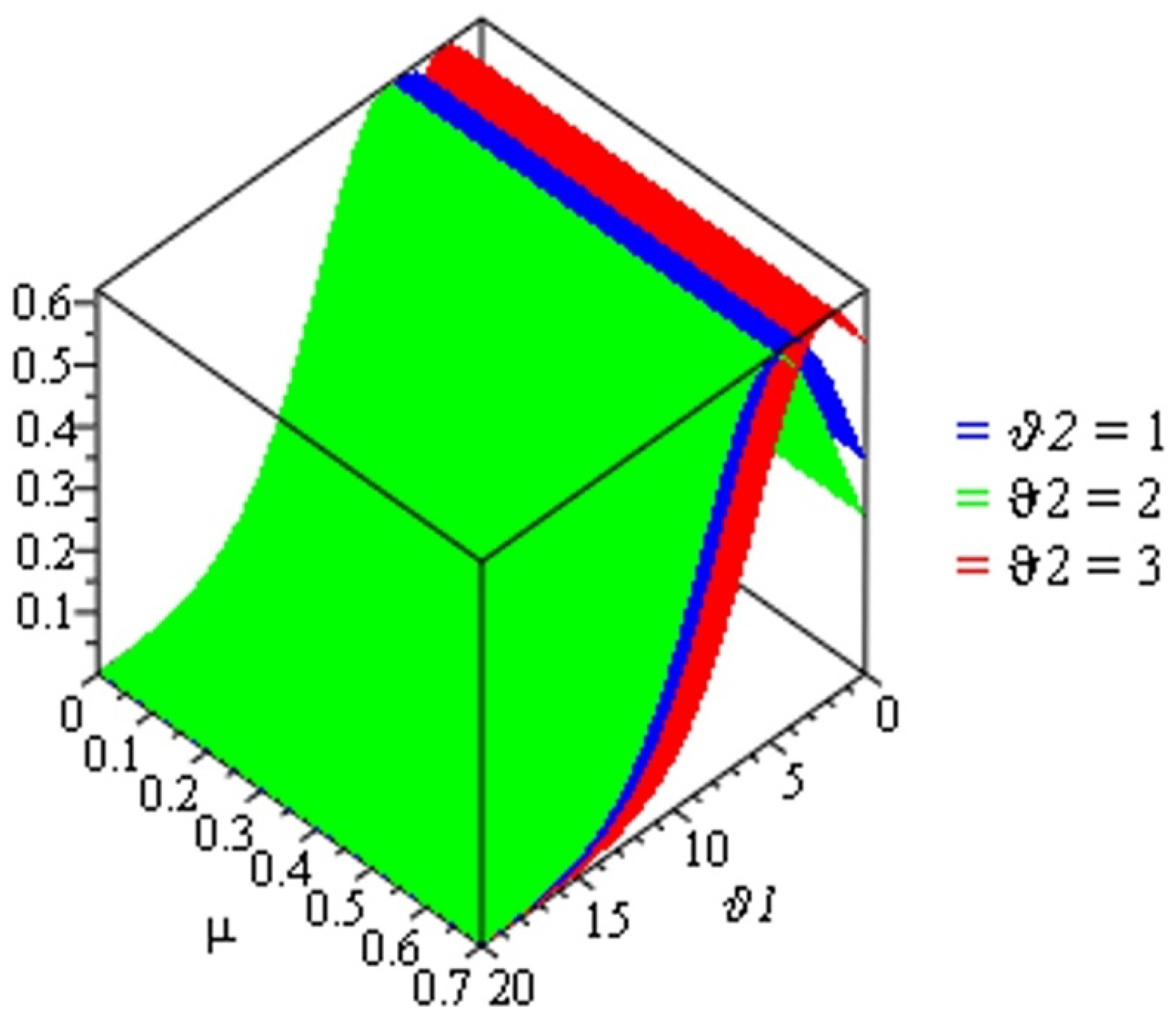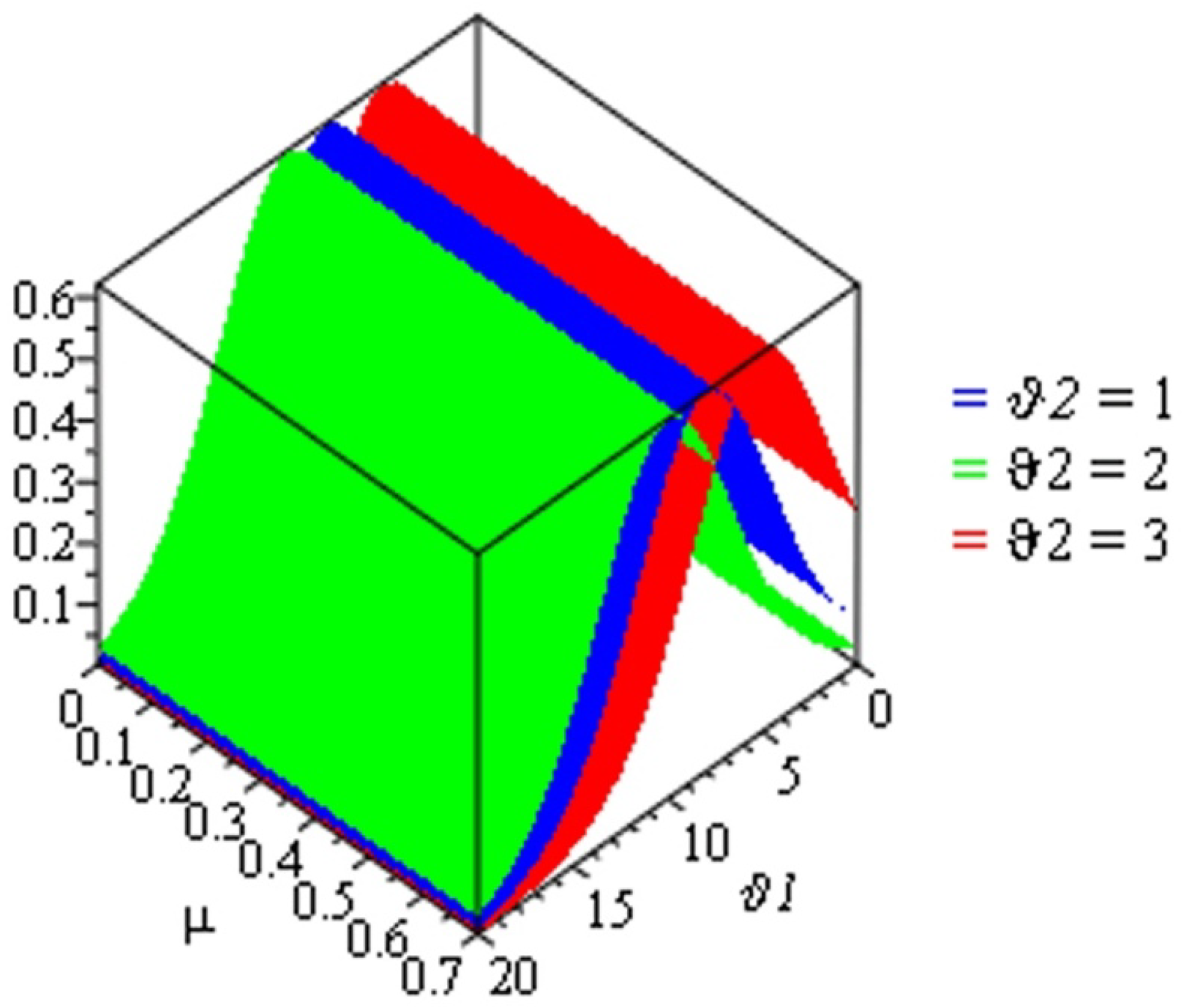On Comparing Analytical and Numerical Solutions of Time Caputo Fractional Kawahara Equations via Some Techniques
Abstract
1. Introduction
2. Aboodh Transform of Caputo Operator
- 1.
- , where and are constants;
- 2.
- , where and are constants;
- 3.
- ;
- 4.
- .
3. The ARPSM Steps
4. Some Applications
5. Numerical Discussion
6. Conclusions
Funding
Data Availability Statement
Conflicts of Interest
References
- Shah, K.; Seadawy, A.R.; Arfan, M. Evaluation of one dimensional fuzzy fractional partial differential equations. Alex. Eng. J. 2020, 59, 3347–3353. [Google Scholar] [CrossRef]
- Damag, F.H.; Saif, A.; Kiliçman, A. φ-Hilfer Fractional Cauchy Problems with Almost Sectorial and Lie Bracket Operators in Banach Algebras. Fractal Fract. 2024, 8, 741. [Google Scholar] [CrossRef]
- Kawahara, T. Oscillatory solitary waves in dispersive media. J. Phys. Soc. Jpn. 1972, 1, 260–264. [Google Scholar] [CrossRef]
- Kaya, D.; Al-Khaled, K. A numerical comparison of a Kawahara equation. Phys. Lett. A 2007, 5–6, 433–439. [Google Scholar] [CrossRef]
- Lu, J. Analytical approach to Kawahara equation using variational iteration method and homotopy perturbation method. Topol. Methods Nonlinear Anal. 2008, 2, 287–293. [Google Scholar]
- Kudryashov, N.A. A note on new exact solutions for the Kawahara equation using Exp-function method. J. Comput. Appl. Math. 2010, 12, 3511–3512. [Google Scholar] [CrossRef]
- Jakub, V. Symmetries and conservation laws for a generalization of Kawahara equation. J. Geom. Phys. 2020, 150, 103579. [Google Scholar] [CrossRef]
- Jin, L. Application of variational iteration method and homotopy perturbation method to the modified Kawahara equation. Math. Comput. Model Dyn. Syst. 2009, 3–4, 573–578. [Google Scholar] [CrossRef]
- Jabbari, A.; Kheiri, H. New exact traveling wave solutions for the Kawahara and modified Kawahara equations by using modified tanh–coth method. Acta Univ. Apulensis Math. Inform. 2010, 23, 21–38. [Google Scholar]
- Wazwaz, A.M. New solitary wave solutions to the modified Kawahara equation. Phys. Lett. A 2010, 4–5, 588–592. [Google Scholar] [CrossRef]
- Kurulay, M. Approximate analytic solutions of the modified Kawahara equation with homotopy analysis method. Adv. Differ. Eq. 2012, 2012, 178. [Google Scholar] [CrossRef]
- Akgul, A.; Cordero, A.; Torregrosa, J.R. A fractional Newton method with 2α-order of convergence and its stability. Appl. Math. Lett. 2019, 98, 344–351. [Google Scholar] [CrossRef]
- Yazgan, T.; Ilhan, E.; Çelik, E.; Bulut, H. On the new hyperbolic wave solutions to Wu-Zhang system models. Opt. Quantum Electron. 2022, 54, 298. [Google Scholar] [CrossRef]
- Rahman, M.U.; Arfan, M.; Shah, Z.; Alzahrani, E. Evolution of fractional mathematical model for drinking under Atangana-Baleanu Caputo derivatives. Phys. Scr. 2021, 96, 115203. [Google Scholar] [CrossRef]
- Tazgan, T.; Çelik, E.; Gulnur, Y.E.L.; Bulut, H. On survey of the some wave solutions of the non-linear Schrödinger equation (NLSE) in infinite water depth. Gazi Univ. J. Sci. 2023, 36, 819–843. [Google Scholar] [CrossRef]
- He, J.H. Homotopy perturbation technique. Comput. Methods Appl. Mech. Eng. 1999, 3–4, 257–262. [Google Scholar] [CrossRef]
- Kilic, S.; Celik, E. Complex solutions to the higher-order nonlinear boussinesq type wave equation transform. Ric. Mat. 2024, 73, 1793–1800. [Google Scholar] [CrossRef]
- Sontakke, B.R.; Shelke, A.S.; Shaikh, A.S. Solution of non-linear fractional differential equations by variational iteration method and applications. Far East J. Math. Sci. 2019, 1, 113–129. [Google Scholar] [CrossRef]
- Dhaigude, D.B.; Kiwne, S.B.; Dhaigude, R.M. Monotone iterative scheme for weakly coupled system of finite difference reaction diffusion equations. Commun. Appl. Anal. 2008, 2, 161–172. [Google Scholar]
- Seadawy, A.R.; Iqbal, M.; Lu, D. Propagation of kink and anti-kink wave solitons for the nonlinear dampedmodified Korteweg-de Vries equation arising in ion-acoustic wave in an unmagnetized collisional dusty plasma. Phys. Stat. Mech. Appl. 2020, 544, 123560. [Google Scholar] [CrossRef]
- Boutarfa, B.; Akgul, A.; Inc, M. New approach for the Fornberg–Whitham type equations. J. Comput. Appl. Math. 2017, 312, 13–26. [Google Scholar] [CrossRef]
- Inc, M.; Akgul, A.; Kilicman, A. Explicit solution of telegraph equation based on reproducing kernel method. J. Funct. Spaces. Appl. 2012, 2012, 984682. [Google Scholar] [CrossRef]
- Akgul, A. A novel method for a fractional derivative with non-local and non-singular kernel. Chaos Solitons Fractals 2018, 114, 478–482. [Google Scholar] [CrossRef]
- Yasmin, H.; Almuqrin, A.H. Analytical study of time-fractional heat, diffusion, and Burger’s equations using Aboodh residual power series and transform iterative methodologies. AIMS Math. 2024, 9, 16721–16752. [Google Scholar] [CrossRef]
- Yang, S.; Song, H.; Zhou, H.; Xie, S.; Zhang, L.; Zhou, W. A Fractional Derivative Insight into Full-Stage Creep Behavior in Deep Coal. Fractal Fract. 2025, 9, 473. [Google Scholar] [CrossRef]
- Yang, S.; Zhou, W.; Xie, X.; Lei, B.; Song, H. Fractional Order Analysis of Creep Characteristics of Sandstone with Multiscale Damage. Mathematics 2025, 13, 2551. [Google Scholar] [CrossRef]
- Damag, F.H.; Saif, A. On Solving Modified Time Caputo Fractional Kawahara Equations in the Framework of Hilbert Algebras Using the Laplace Residual Power Series Method. Fractal Fract. 2025, 9, 301. [Google Scholar] [CrossRef]
- Liaqat, M.I.; Etemad, S.; Rezapour, S. A novel analytical Aboodh residual power series method for solving linear and nonlinear time-fractional partial differential equations with variable coefficients. AIMS Math. 2022, 7, 16917–16948. [Google Scholar] [CrossRef]
- Edalatpanah, S.A.; Abdolmaleki, E. An innovative analytical method utilizing aboodh residual power series for solving the time-fractional newell-whitehead-segel equation. Comput. Algorithms Numer. Dimens. 2024, 3, 115–131. [Google Scholar]
- Noor, S.; Albalawi, W.; Shah, R.; Al-Sawalha, M.M.; Ismaeel, S.M.; El-Tantawy, S.A. On the approximations to fractional nonlinear damped Burger’s-type equations that arise in fluids and plasmas using Aboodh residual power series and Aboodh transform iteration methods. Front. Phys. 2024, 12, 1374481. [Google Scholar] [CrossRef]
- Liaqat, M.I.; Akgül, A.; Abu-Zinadah, H. Analytical Investigation of Some Time-Fractional Black–Scholes Models by the Aboodh Residual Power Series Method. Mathematics 2023, 11, 276. [Google Scholar] [CrossRef]
- Culha Unal, S. Approximate solutions of time fractional Kawahara equation by utilizing the residual power series method. Int. J. Appl. Math. Comput. Sci. 2022, 8, 78. [Google Scholar]
- Pavani, K.; Raghavendar, K. An efficient technique to solve time-fractional Kawahara and modified Kawahara equations. Symmetry 2022, 14, 1777. [Google Scholar] [CrossRef]
- Zafar, H.; Ali, A.; Khan, K.; Sadiq, M.N. Analytical solution of time fractional Kawahara and modified Kawahara equations by homotopy analysis method. Int. J. Appl. Math. Comput. Sci. 2022, 8, 94. [Google Scholar] [CrossRef]
- Dhaigude, D.B.; Bhadgaonkar, V.N. A novel approach for fractional Kawahara and modified Kawahara equations using Atangana-Baleanu derivative operator. J. Math. Comput. Sci. 2021, 3, 2792–2813. [Google Scholar]
- Rahman, M.U.; Arfan, M.; Deebani, W.; Kumam, P.; Shah, Z. Analysis of time-fractional Kawahara equation under Mittag-Leffler Power Law. Fractals 2022, 30, 2240021. [Google Scholar] [CrossRef]
- Bhatter, S.; Mathur, A.; Kumar, D.; Nisar, K.S.; Singh, J. Fractional modified Kawahara equation with Mittag–Leffler law. Chaos Solitons Fractals 2020, 131, 109508. [Google Scholar] [CrossRef]
- Ak, T.; Karakoc, S.B. A numerical technique based on collocation method for solving modified Kawahara equation. J. Ocean. Eng. Sci. 2018, 3, 67–75. [Google Scholar] [CrossRef]
- Damag, F.H.; Kılıçman, A.; Al-Arioi, A.T. On Hybrid Type Nonlinear Fractional Integrodifferential Equations. Mathematics 2020, 8, 984. [Google Scholar] [CrossRef]
- Oqielat, M.A.; Eriqat, T.; Ogilat, O.; El-Ajou, A.; Alhazmi, S.E.; Al-Omari, S. Laplace-residual power series method for solving time-fractional reaction–diffusion model. Fractal Fract. 2023, 309, 309. [Google Scholar] [CrossRef]





| AE (ARPSM) | AE (NTDM) [33] | AE (RPSM) [32] | |
|---|---|---|---|
Disclaimer/Publisher’s Note: The statements, opinions and data contained in all publications are solely those of the individual author(s) and contributor(s) and not of MDPI and/or the editor(s). MDPI and/or the editor(s) disclaim responsibility for any injury to people or property resulting from any ideas, methods, instructions or products referred to in the content. |
© 2025 by the author. Licensee MDPI, Basel, Switzerland. This article is an open access article distributed under the terms and conditions of the Creative Commons Attribution (CC BY) license (https://creativecommons.org/licenses/by/4.0/).
Share and Cite
Damag, F.H. On Comparing Analytical and Numerical Solutions of Time Caputo Fractional Kawahara Equations via Some Techniques. Mathematics 2025, 13, 2995. https://doi.org/10.3390/math13182995
Damag FH. On Comparing Analytical and Numerical Solutions of Time Caputo Fractional Kawahara Equations via Some Techniques. Mathematics. 2025; 13(18):2995. https://doi.org/10.3390/math13182995
Chicago/Turabian StyleDamag, Faten H. 2025. "On Comparing Analytical and Numerical Solutions of Time Caputo Fractional Kawahara Equations via Some Techniques" Mathematics 13, no. 18: 2995. https://doi.org/10.3390/math13182995
APA StyleDamag, F. H. (2025). On Comparing Analytical and Numerical Solutions of Time Caputo Fractional Kawahara Equations via Some Techniques. Mathematics, 13(18), 2995. https://doi.org/10.3390/math13182995






